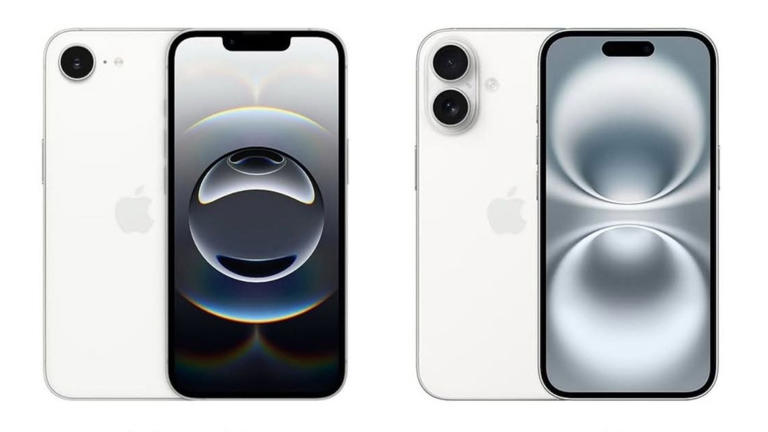iPhone 16e vs iPhone 16: Which One Should You Pick?
Apple’s iPhone lineup has long been a benchmark for smartphone innovation, and with the release of the iPhone 16 series in 2024, the company continues to cater to a wide range of users. Among the lineup, two models have sparked curiosity: the standard iPhone 16 and the mysterious iPhone 16e. But what sets these two apart, and which one is the right choice for you? Let’s break it down.
Design and Build
The iPhone 16 sticks to Apple’s premium design ethos—think sleek aluminum edges, a Ceramic Shield front, and a glass back, available in vibrant colors like Midnight Blue, Starlight, and a bold new Red. It’s lightweight yet durable, with an IP68 rating for water and dust resistance.
The iPhone 16e, on the other hand, seems to take a slightly different approach. Rumors suggest the “e” stands for “essential” or “economy,” hinting at a more budget-friendly design. It might swap the glass back for a high-quality polycarbonate to cut costs, while retaining a similar form factor. The color options could be more subdued—perhaps Black, White, and a single pastel shade like Mint Green. Despite the changes, it’s still expected to carry IP68 resistance, ensuring durability isn’t sacrificed.
Winner: iPhone 16, for its premium materials and broader color palette.
Display
The iPhone 16 boasts a 6.1-inch Super Retina XDR OLED display with a 120Hz ProMotion refresh rate—a feature once reserved for Pro models. This makes scrolling buttery smooth and gaming more immersive, with brightness peaking at 2,000 nits for excellent outdoor visibility.
The iPhone 16e, by contrast, might dial things back to keep costs down. Picture a 6.1-inch Super Retina OLED but capped at a 60Hz refresh rate and a slightly lower peak brightness (around 1,600 nits). It’s still a stunning screen for most users, but it lacks the fluidity of ProMotion.
Winner: iPhone 16, thanks to ProMotion and brighter visuals.
Performance
Both models are powered by the same A18 Bionic chip, Apple’s latest silicon marvel built on a 3nm process. With a 6-core CPU, 5-core GPU, and a 16-core Neural Engine, the A18 delivers blazing-fast performance for multitasking, gaming, and AI-driven features like enhanced Siri responses. Whether you’re editing 4K videos or playing Genshin Impact, neither phone will break a sweat.
The difference? The iPhone 16e might come with 4GB of RAM instead of the 6GB in the iPhone 16. For everyday use, this won’t matter much, but heavy multitaskers or power users might notice a slight edge with the standard model over time.
Winner: iPhone 16, for that extra RAM headroom.
Cameras
The iPhone 16 sports a dual-camera system: a 48MP wide sensor with a 2x in-sensor zoom and a 12MP ultrawide lens. New computational photography tricks, like improved Night Mode and Cinematic Mode at 4K 60fps, make it a photography powerhouse for its price.
The iPhone 16e could take a step back here, potentially sticking with a 12MP wide and 12MP ultrawide setup—similar to the iPhone 14 or 15. It’d still benefit from Apple’s image processing, but you’d miss out on the higher resolution and zoom versatility of the 48MP sensor.
Winner: iPhone 16, for its superior camera hardware.
Battery Life and Charging
Battery life on the iPhone 16 is impressive, lasting up to 20 hours of video playback, thanks to the efficient A18 chip and a slightly larger battery. It supports 20W wired charging and 15W MagSafe wireless charging.
The iPhone 16e might offer similar endurance—say, 18-19 hours—due to its less demanding display. However, it could lack MagSafe support, sticking to basic 15W wireless charging to keep costs low. Both phones charge to 50% in about 30 minutes with a fast charger (sold separately, of course).
Winner: Tie—battery life is close enough, but iPhone 16 edges out for MagSafe.
Price
Here’s where the iPhone 16e shines. The iPhone 16 starts at $799 for 128GB, a fair price for its features. The iPhone 16e, positioned as a more affordable option, could debut at $649 or $699—making it a tempting pick for budget-conscious buyers who still want the Apple ecosystem.
Winner: iPhone 16e, for its lower entry price.
Which One Should You Pick?
- Choose the iPhone 16 if: You want the full premium experience—smoother display, better cameras, and a design that turns heads. It’s ideal for creatives, gamers, or anyone who values cutting-edge tech.
- Choose the iPhone 16e if: You’re looking to save some cash without sacrificing core performance. It’s perfect for casual users, students, or those upgrading from older models like the iPhone 12 or 13.
The iPhone 16 is the stronger all-rounder, delivering flagship features in a polished package. But the iPhone 16e could be a sleeper hit for those who don’t need the extras and prefer a lower price tag. Ultimately, your choice depends on your budget and priorities—either way, you’re getting a top-tier smartphone backed by Apple’s ecosystem and years of software updates.
What do you think—would you splurge on the iPhone 16 or save with the 16e? Let us know!















